News
Do we think about tail-enders batting ability?
In the game of Cricket, tail-enders are the ones who are at the bottom of a score sheet or the players who have a lower level of batting ability. Normally, in a match, if a side loses 6 or 7 wickets, their tail-enders start coming to bat and that batting team’s innings probably finish in a short time period. But there are some tailenders who show great resistance to the bowling team and frustrate the bowling team when these tailenders come to bat.
But most of the time these tailenders come and just throw the bat at deliveries and give away their wicket irresponsibly. Sometimes tail-enders or these proper bowlers don’t think about their batting because they think their duty is just bowling or sometimes teams and their management don’t pay attention to the batting of their tailenders or sometimes teams and their management think and talk about uplifting the batting ability of their tail-enders but not implement them in the practice sessions.
For example, history and records tell that Bangladesh, Sri Lanka and West Indies produce tail-enders with the worst batting ability while England, Australia, and New Zealand produce tail-enders with enough ability in batting. Also, the Indians produce tail-enders who have the ability in batting from the last few years.
If a side has strong tail-enders, that team can put extra 30-40 runs or more to their tally and that team will increase the confidence of their team and their batting department.
For solving this problem, basically, teams and coaches must put these tail-enders on nets and to side wickets and must practice them regularly or individually these tail-enders have to focus on their batting as well as their bowling. And that can increase the batting ability of tail-enders and can cause the success of a team. But this would not be a long-term solution or the most effective solution because it’s not easy to learn a skill when players come to the elite level and not easy to put a skill into muscle memory when players become adults.
Because of that, the best stage to uplift the batting ability of tail-enders is School Cricket. Most of the time in school cricket, the bowlers of a team don’t get a chance to bat in practice sessions and they just bat two, or three times a month in the middle and ask to do well in match situations when they don’t have enough batting practice and confidence. Because these school tail-enders carry this cycle for a longer period of time, they become typical tail-enders who don’t have the ability to bat, and who just have to hang around in the crease when coming to bat after they become elite international players. Bangladesh, Sri Lanka and West Indies face the consequences of this. For that school coaches must get the responsibility to train tail-enders in batting and coaches must influence their tail-enders to do training in batting individually. Also, school coaches can give batting tasks in practices as well as in matches for their tail-enders, and coaches must give confidence and uplift the confidence of their school team tail-enders.
By Chathushka Kalunayaka
Cricket
Virat Kohli Overtakes Sanath Jayasuriya in Player-of-the-Series Awards
Indian superstar Virat Kohli has overtaken Sri Lankan legend and current national head coach Sanath Jayasuriya in the list of most Player-of-the-Series awards in international cricket.
Kohli now moves to 12 series awards, surpassing Jayasuriya’s long-standing tally of 11, which placed the Sri Lankan great among the top performers in cricket history.
All-Time Most Player-of-the-Series Awards in International Cricket
- Sachin Tendulkar (India): 15 awards, 108 series, 1989–2012
- Virat Kohli (India): 12 awards, 76 series, 2008–2025
- Sanath Jayasuriya (Sri Lanka/Asia XI): 11 awards, 111 series, 1989–2011
- Shaun Pollock (South Africa/Africa XI/ICC): 9 awards, 60 series, 1996–2008
- Chris Gayle (West Indies/ICC): 8 awards, 71 series, 1999–2019
Despite being surpassed, Jayasuriya’s record — built across an illustrious career from 1989 to 2011 — remains a monumental achievement, highlighting his impact on world cricket as one of the most dominant all-round match-winners of his era.
Kohli’s latest milestone further strengthens his status as one of the modern game’s most consistent performers.
Football
Sri Lanka Fall 2–1 to Timor-Leste in Final Group Match, Ending AFC U-17 Asian Cup Qualifiers Campaign
Sri Lanka’s AFC U-17 Asian Cup Qualifiers campaign came to an unexpected conclusion with a 2–1 defeat to Timor-Leste in their final Group A match in Chongqing. With both teams entering the fixture on three points, the match served as a direct battle for a fourth-place finish in the group. Despite pre-match expectations and form analysis suggesting Sri Lanka held the advantage, Timor-Leste delivered the stronger performance on the day.
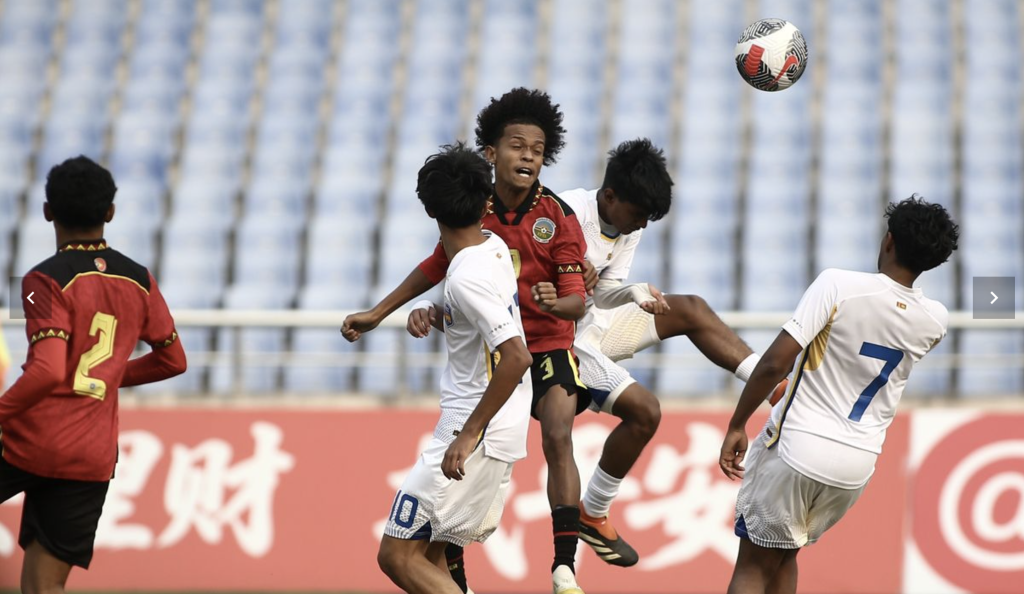
Timor-Leste took control early and displayed greater urgency, breaking the deadlock in the 26th minute through Elton Da Conceicao, who capitalised on defensive hesitation to put his side ahead. Sri Lanka struggled to settle into rhythm, often losing second balls and failing to connect effectively in midfield.
The second half saw Timor-Leste continue to dictate play, maintaining higher intensity and pressing Sri Lanka into mistakes. Their persistence was rewarded in the 63rd minute when Jyzeus Gabriel Lay doubled the lead with a composed finish following a break in transition.
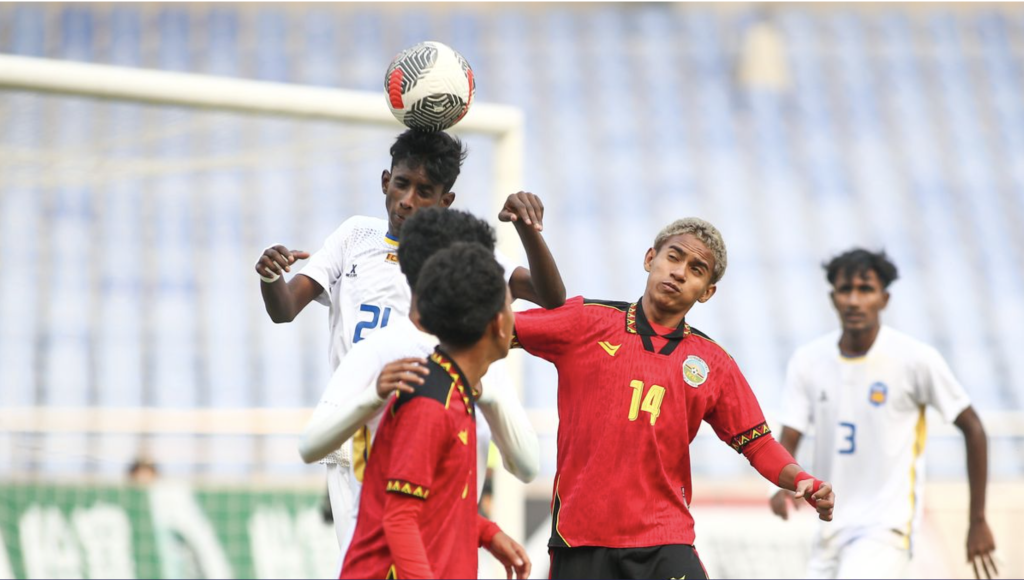
Sri Lanka managed to pull one goal back deep into stoppage time, as Ishaq found the net with a well-taken effort, but it was too late to alter the outcome. The result places Sri Lanka fifth in Group A, behind China PR, Bangladesh, Bahrain, and now Timor-Leste.
This outcome contradicts earlier projections that favoured Sri Lanka based on Timor-Leste’s previous results and goal difference. However, football at youth level often hinges on momentum, confidence, and adaptability—areas where Timor-Leste outperformed Sri Lanka on the day.
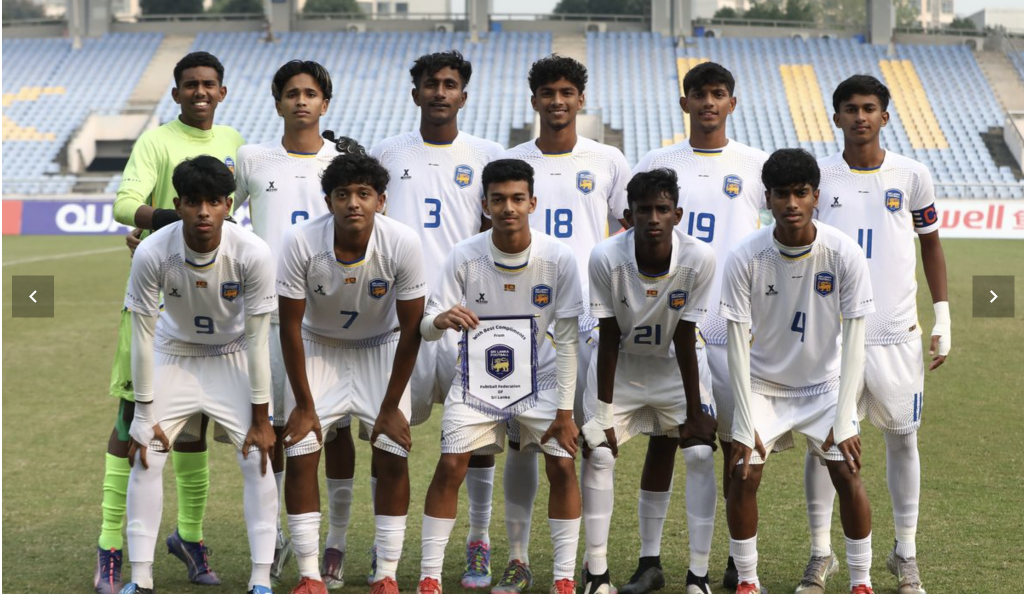
Sri Lanka conclude their campaign with one win and four losses, scoring six goals and conceding 17. While the tournament exposed defensive vulnerabilities and structural weaknesses, it also offered valuable international experience for a young squad still developing physically and tactically.
The focus now shifts to refining youth systems, improving defensive organisation, and strengthening player development pathways. The qualifiers may not have produced the results Sri Lanka had hoped for, but they provided clarity on the areas that require attention as the nation continues to rebuild at youth level.
Football
Sri Lanka Suffer 8–0 Defeat to China PR in AFC U-17 Asian Cup Qualifiers – Matchday 4 Update
Sri Lanka’s AFC U-17 Asian Cup Qualifiers campaign took another difficult turn on Matchday 4 as they fell 8–0 to a dominant China PR side in Chongqing. China, who entered the fixture with 30 goals scored and none conceded, continued their perfect run with a commanding and clinical performance.
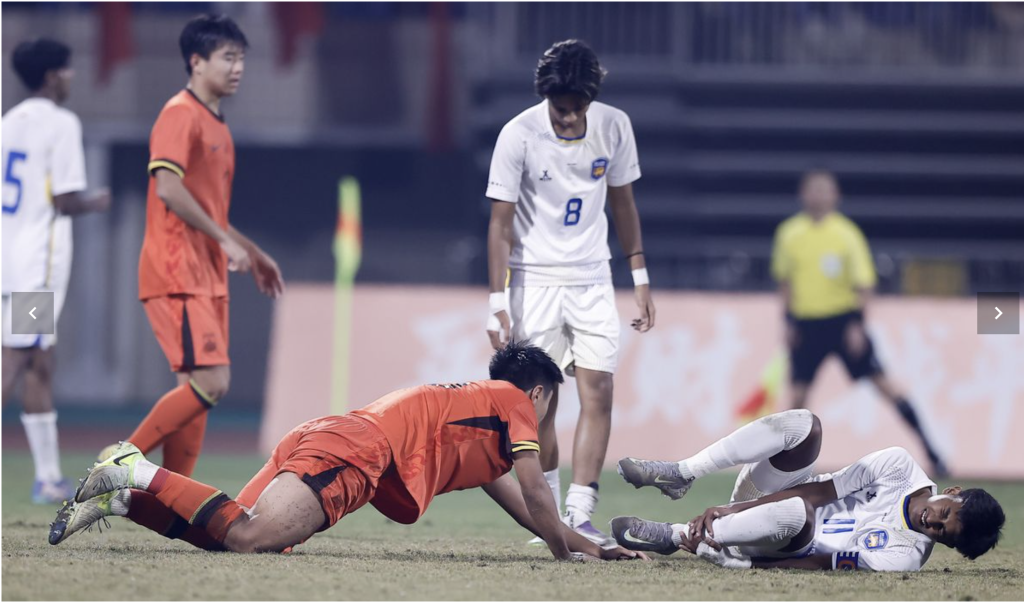
The defeat also slightly exceeded the earlier projected scoreline, as forecasts suggested a heavy loss in the range of 6–0 based on China’s form and Sri Lanka’s defensive struggles. China ultimately pushed beyond that margin with relentless second-half pressure and superior physicality.
China took control early when Zhao Songyuan opened the scoring in the 13th minute. Zhang Xuyao doubled the lead before the half-hour mark, and Kuang Zhaolei’s 41st-minute strike effectively settled the outcome before halftime.
The second half offered little relief for Sri Lanka. China maintained full command of possession and territory, adding five more goals through He Sifan (47’), Shuai Weihao (55’), Wan Xiang (75’, 77’) and Zhang Bolin (84’). The hosts’ sustained pressure, intelligent movement between the lines, and ruthless finishing highlighted the gap between the two nations at this age level.
With the win, China remain unbeaten with four straight victories, keeping pace with Bangladesh at the top of Group A. Owing to a significantly superior goal difference, China will only need a draw against Bangladesh on Sunday to finish as group leaders.
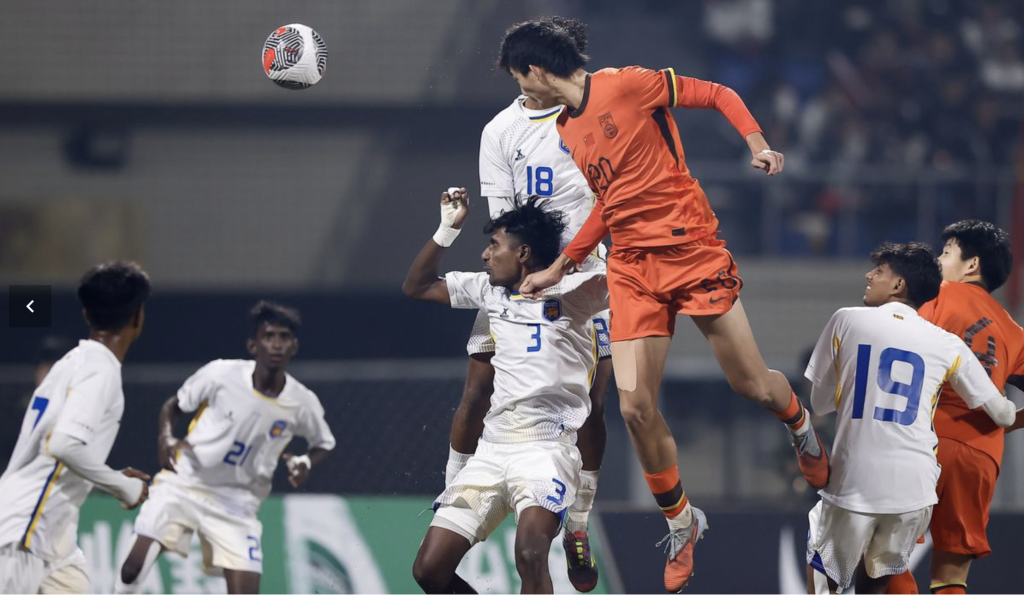
For Sri Lanka, the result reinforces the defensive and structural challenges identified throughout the campaign — particularly in dealing with high-pressing teams and managing space between defensive lines. The team now turns its attention to their final group match against Timor-Leste, a fixture they are expected to approach with confidence and a realistic chance of securing a second victory.
Sri Lanka have one match remaining in the qualifiers and will aim to finish on a stronger note as they continue their learning curve at continental level.
If you need an updated standings table, match preview for Sri Lanka vs Timor-Leste, or social media posts for this result, I can prepare those next.
Updated Group A Standings (After Matchday 4)
| Team | P | W | D | L | GF | GA | GD | Points |
|---|---|---|---|---|---|---|---|---|
| China PR | 4 | 4 | 0 | 0 | 38 | 0 | +38 | 12 |
| Bangladesh | 4 | 4 | 0 | 0 | 23 | 5 | +18 | 12 |
| Bahrain | 4 | 2 | 0 | 2 | 7 | 6 | +1 | 6 |
| Sri Lanka | 4 | 1 | 0 | 3 | 5 | 15 | -10 | 3 |
| Timor-Leste | 4 | 0 | 0 | 4 | 0 | 30 | -30 | 0 |
| Brunei Darussalam | 4 | 0 | 0 | 4 | 0 | 24 | -24 | 0 |
Sri Lanka vs Timor-Leste – Match Preview
Sri Lanka enter their final AFC U-17 Asian Cup Qualifiers Group A match against Timor-Leste with a crucial opportunity to end the campaign on a positive note. Both teams have faced heavy defeats throughout the group stage, with Timor-Leste failing to score a single goal and conceding 30.
Sri Lanka showed strong attacking quality in their 4–0 win over Brunei and were competitive in stretches against Bahrain before losing 2–1. Despite the 8–0 loss to China PR, the team retains the advantage in pace, transitional play, and individual technical ability over Timor-Leste.
Timor-Leste have struggled to maintain defensive shape and have been vulnerable in both wide areas and in transition. Their inability to build out from pressure offers Sri Lanka a clear opportunity to dominate possession and control attacking phases.
This match represents Sri Lanka’s best chance to secure a second win and finish the group in fourth place.
Match Prediction – Sri Lanka vs Timor-Leste
The previous prediction for this match was 3–1 in favour of Sri Lanka.
Based on both teams’ updated performances and form trends, this prediction remains accurate.
Predicted result: Sri Lanka 3–1 Timor-Leste
Sri Lanka are expected to:
• Control the midfield
• Create more chances from wide areas
• Use pace effectively in transition
• Limit Timor-Leste’s attacking threat
-

 Football10 months ago
Football10 months agoSri Lanka Schools National Championship 2025: Super 8 Fixtures and Grouping
-

 News11 months ago
News11 months ago2025 Schools Rugby Season Set to Thrill Fans with Knockout and League Action
-

 Live4 years ago
Live4 years agoLive Broadcast of Syria vs Sri Lanka | AFC U23 Asian Championship Qualification
-

 Cricket7 months ago
Cricket7 months agoNuwan Thushara Shines as RCB Storms into IPL 2025 Final
-

 Football11 months ago
Football11 months agoFFSL Rebrands Division-1 as ‘League-One’ with a Bold New Vision
-

 News7 months ago
News7 months agoMajor Shake-Up in Sports Governance: New 2025 Regulations Reform National Sports Bodies in Sri Lanka
-

 Cricket11 months ago
Cricket11 months agoSri Lanka’s Greatest Cricketers: Top Batters and Bowlers of All Time
-
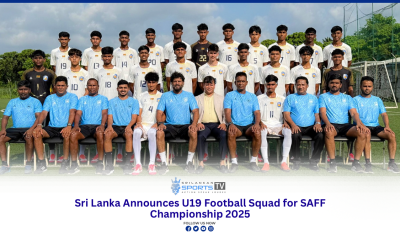
 Football7 months ago
Football7 months agoSri Lanka Announces U19 Football Squad for SAFF Championship 2025







